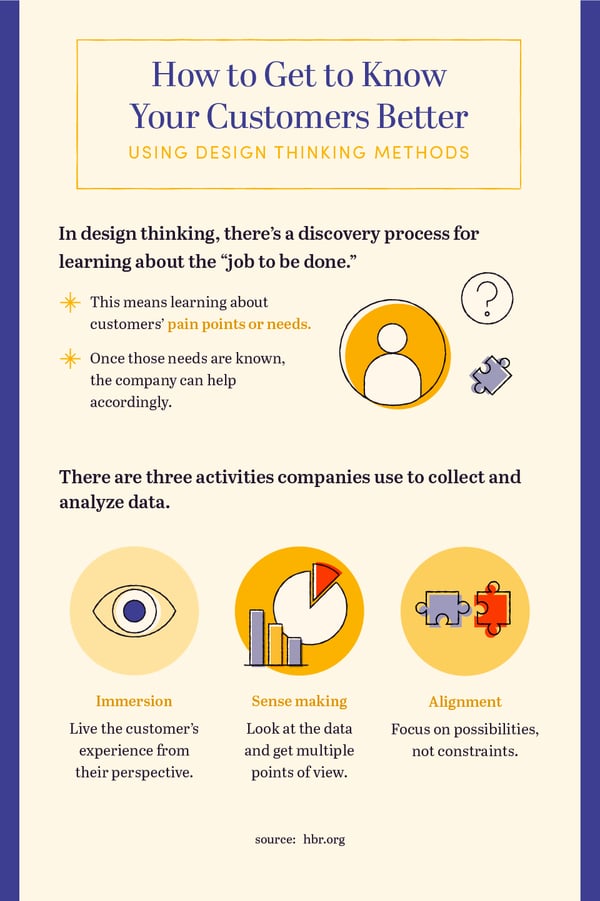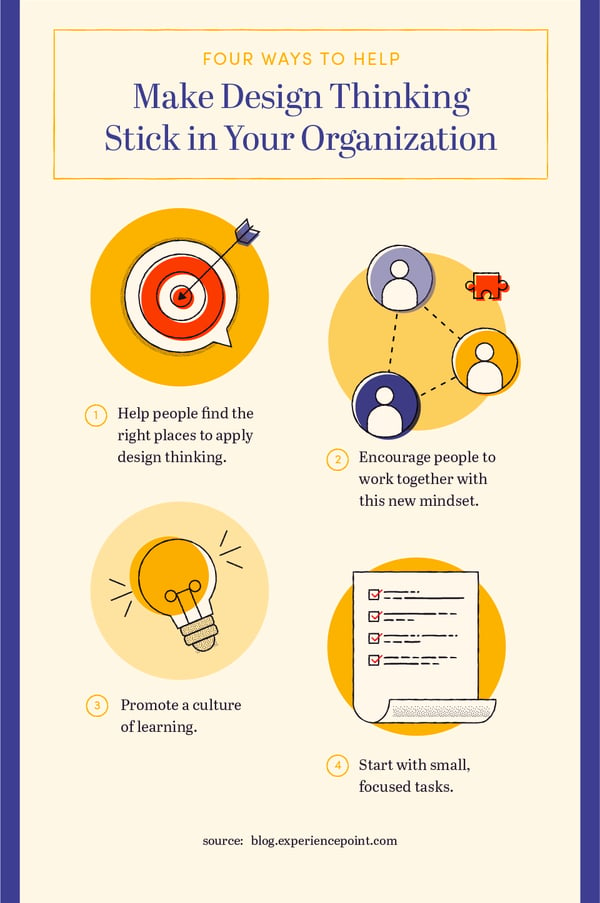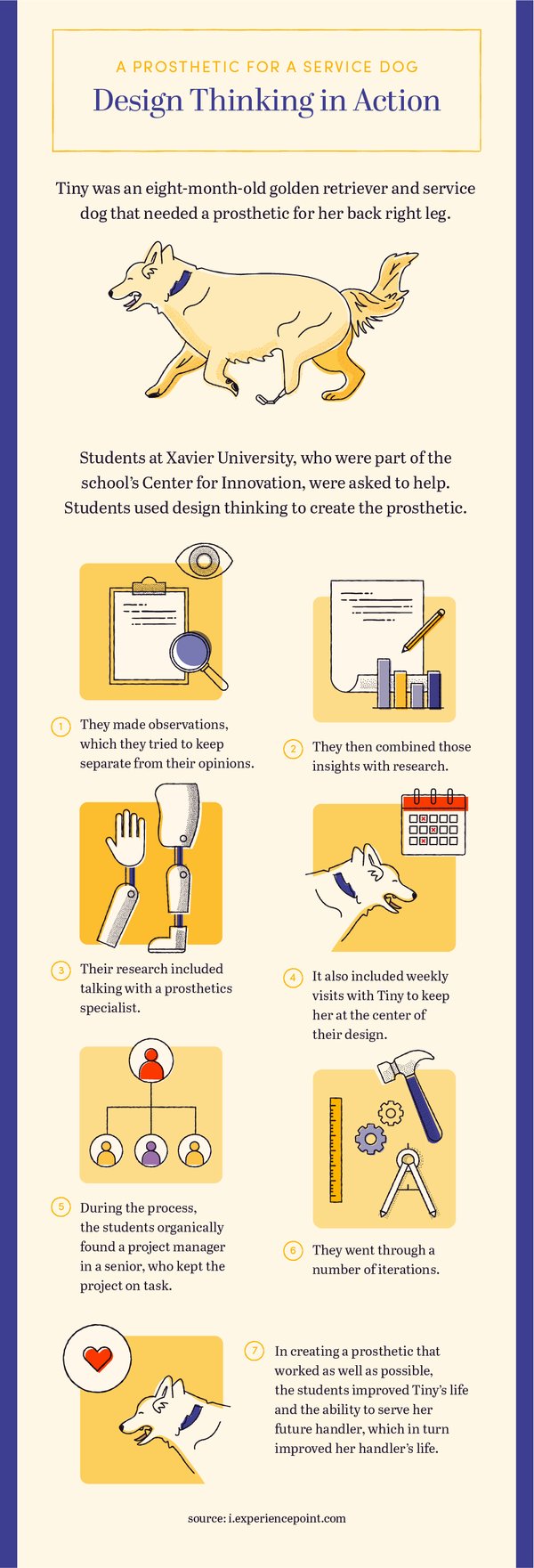Make Your Company Customer-Centric
with Design Thinking
A hypothetical company is customer-centric. It monitors its interactions with customers, pushes hard to improve KPIs, and pays attention to industry trends. When it sees an opportunity to improve its product, it does, whether that inspiration comes from something a manager saw on Facebook or because the opportunity and supplies are available. The company is forward-thinking and has driven, loyal employees. Customers are happy, though not necessarily as loyal as they could be, and managers meet on a monthly basis to discuss metrics, recorded customer service calls, and potential improvements to their loyalty program.
This company is doing well. It will continue to make sales and improve its metrics. It will, however, remain average: It won’t be seen as the leader in its industry. But it stays in the black.
How Can Design Thinking Take a Company From Average to Exceptional?
Design thinking flips the strategy from focusing on results — metrics, sales, and other data points — to focusing on what customers say, want, and need. It sounds obvious. In a world full of numbers that managers want to improve, however, what often gets lost are the subjective needs and wants customers have.
Keith LaPlante writes, “Companies are so eager to build a new product that they never take the time to validate whether it’s something the customers even want.”

Design thinking takes customers and truly puts them at the center of a company’s strategy. It’s essentially asking what they want, then providing it, and it’s known for helping organizations solve some of their biggest, most complex challenges. The process for design thinking has seven steps, depending on who you ask:
-
Identify the problem.
-
Define your goals.
-
Assess your alternatives.
-
Prototype the solution you chose.
-
Evaluate the results, then iterate.
Companies that don’t have design thinking as a part of their strategy likely already follow a version of this process. When this process is done with the tenets of design thinking, it’s a far more effective and powerful procedure.
Design Thinking Should be Part of Every Organization’s Strategy.
While design thinking seems to imply that it should be managed by designers, it can actually be used in any company and managed by anyone willing to try something new. According to IDEO, “Design thinking relies on the human ability to be intuitive, to recognize patterns, and to construct ideas that are emotionally meaningful as well as functional.”
The person in an organization who’s in charge of guiding your design thinking process should have, at the least, two primary characteristics: empathy and curiosity. Kaan Turnali, in an article for Forbes, writes of people who practice design thinking, “We embrace the empathy principle by living and experiencing our users’ pain points and state of mind strictly from their perspective.”
The key to design thinking and to being a customer-centric company is to put your customers first. Work to understand them and learn what they need, and then strive to provide for that need. Any company willing to put forth the effort to do that is making design thinking a part of their business strategy.
Incorporate design thinking slowly, and remember your end goal.
The point of design thinking is to help customers feel more satisfied with their relationship with your company. By improving your relationship with people who support your business, you should be able to increase loyalty, sales, and, as a byproduct, your most important KPIs.
The article “Four Ways to Make Design Thinking Stick in Your Organization” is for an audience who has gone to a design thinking workshop. In the spirit of that article, here are four ways to implement this strategy for the first time.
-
Help people find the right places to apply design thinking.
This includes working with your team to identify complex challenges that are centered on your customers. -
Encourage people to work together with this new mindset.
It’s easy to fall back into old habits, such as trying to emulate successful launches from other companies in your industry. Work together to remember the power of keeping your customers’ needs front and center — and why that works better in the long run. -
Promote a culture of learning.
Ask your team members to teach each other what they’ve learned. This includes what they learn about design thinking as well as what they learn about your customers. -
Start with small, focused tasks.
Have a brainstorming session, or just a meeting where you ask, “How might we?”
Your end goal in all of this — implementing design thinking, using its process, and upending your traditional ways of solving your business’s big challenges — is to keep your customer at the center of everything you do.

Why is a Customer-Centric Business Model Ideal?
Design thinking assumes a company wants to put its customers first. But why is this a good business model?
A company can produce any number of products and services, have the most incredible website, hire the top employees for each department, and have an excellent reputation. It can do everything right, but without customers, it will not survive.
Customers are the key. Keeping customers happy is just as important as introducing new customers to your company. This is why design thinking works: Since design thinking is entirely founded on what your customers actually need, it helps companies improve their relationships with them.
One way to start using design thinking is to step into your customers’ shoes. Instead of relying on your interpretations of surveys or what focus groups say, take the time to act like a customer. For example, would you trust a person who has never driven a car to design a vehicle? If you don’t mop your floors, can you really understand the pain points of someone who does?

But that mindset only goes so far, obviously. Sometimes, you can’t fully empathize with your customer, but design thinking can still be used. With research, observation, interviews with experts, and a willingness to try, fail, and iterate, you can still sympathize — and, therefore, know how to help. Students at Xavier University did just that when they helped build a prosthetic leg for Tiny, a service dog: “Having experienced the importance of observing and keeping observations separate from opinions, students were deliberate about focusing in on the dog, watching what it was doing and taking notes on those observations.” They also spoke with a children’s prosthetics specialist for more insights.
That’s a lot of work for one dog and one prosthetic — but it worked. If it hadn’t worked, the dog wouldn’t be able to wear the prosthetic or do her job, which would’ve then impacted her handler. The consequences of a job done poorly were far-reaching, but with design thinking, the students improved the lives of everyone (and every dog) involved.
If your company is trying to push to the next level and become more competitive in its market, consider turning to design thinking. This new mindset may take time to really sink in, and it takes effort to start, but once it is a part of your business strategy and company culture, your company will be truly customer-centric.
Want to learn more about design thinking?